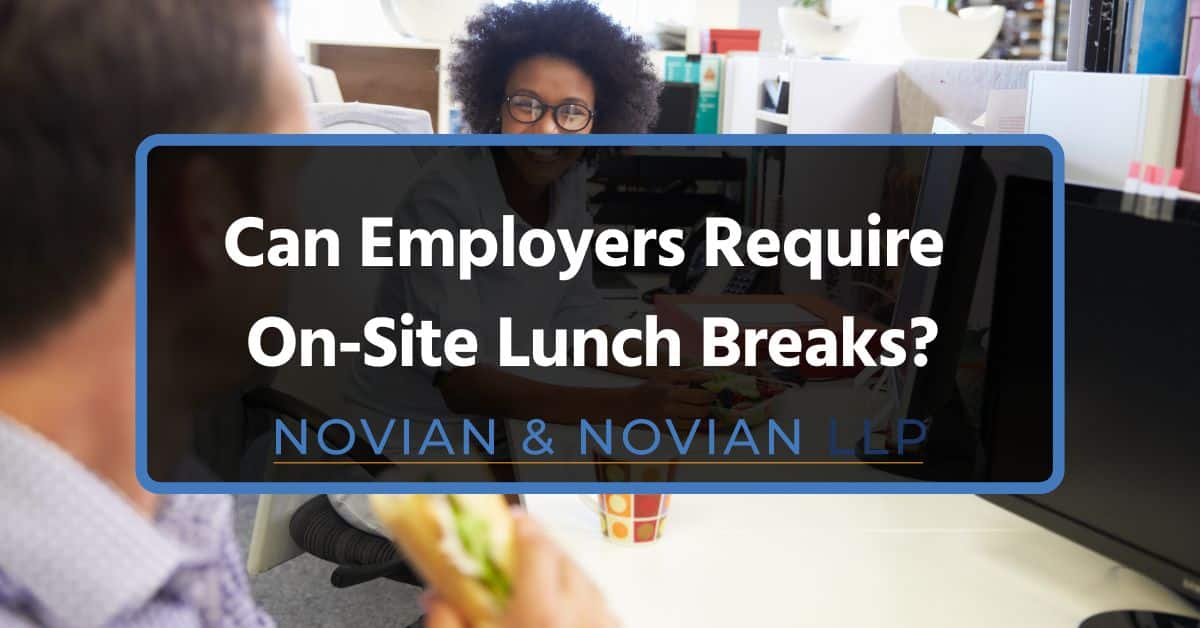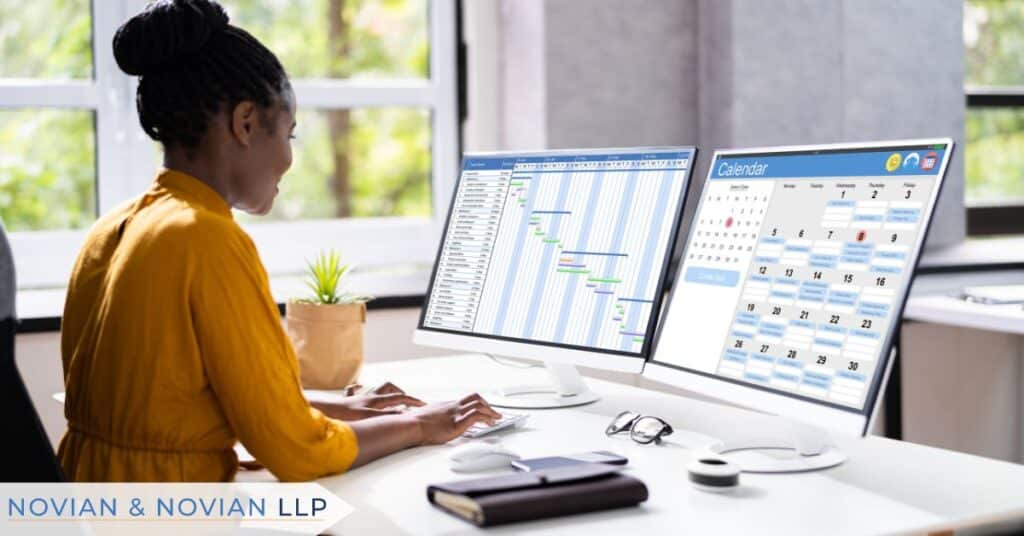
| May 8, 2024 | Employment Law
In California, labor regulations are essential for controlling lunch breaks and protecting employees’ rights. These regulations guarantee employees a 30-minute meal break if they work more than 5 hours and another break for those who work more than 10 hours a day. Companies that do not give these required breaks risk being fined and penalized for breaking labor laws.
In general, companies in California are not allowed to require their workers to remain on the premises during meal breaks. Employees are allowed to leave the premises at any time and are required to be relieved of all responsibilities during this time.
Novian’s Employer Defense Attorneys provide expert advice on employment law issues like lunch breaks and compliance. With decades of experience, we have successfully navigated challenging labor law cases and protected our client’s rights. We also offer free consultations with personalized support and a wealth of experience, making us a trusted choice for dependable legal assistance.
In this blog, we will explore the nuances of workplace laws and employee rights, highlighting important issues related to lunch breaks for both employers and employees.
Can an Employer Make You Stay on Site for Lunch in California?
Sections 512 and 226.7 of the California Labor Code, as well as the Industrial Welfare Commission Wage Orders, are the main labor regulations that control meal breaks and employee rights in the state. These regulations require workers who work for more than five hours a day to have a 30-minute uninterrupted meal break. During this time, they must be free from all obligations and allowed to leave the office. Giving workers a chance to unwind and refresh away from the office and letting them leave the building during lunch breaks has been proven to have a positive effect on an employee’s well-being and productivity.
However, depending on the circumstances or the nature of the work, eating lunch at the working site may be necessary occasionally. For example, staff who operate in distant regions, provide security, perform healthcare while on duty, or are otherwise unable to leave the premises during meal breaks may be required to remain on-site for operational purposes.
It’s important to mention that California’s laws governing on-site rest and meal breaks specify that employers are not allowed to supervise staff members during meal breaks, even if they are compelled to remain on the premises. Workers must be released from all obligations and given the freedom to leave the office.
Furthermore, rest breaks must provide bona fide free time for employees to pursue personal interests without interference from their employers. This ensures that employees can enjoy truly refreshing and rejuvenating breaks.
Employee Rights and Employer Obligations
If employees believe their rights are being violated, they can consider a number of actions. First and foremost, they must follow the company’s grievance reporting standards and procedures. They can also look into official complaint channels, such as registering a formal complaint with the California Labor Commissioner’s Office.
Enforcing labor laws and investigating complaints about workplace safety, pay and hour breaches, and other labor-related matters are important tasks for this agency. Employees may use these tools to advocate for their rights and hold companies accountable for following California labor laws.
Responsibilities of an Employer Towards Lunch Breaks
Employers are responsible for ensuring that workers adhere to labor rules, such as Industrial Welfare Commission wage orders and California Labor Code Sections 512 and 226.7. These regulations require workers who work more than five hours a day to have a 30-minute uninterrupted meal break. During this time, they must be free from all obligations and allowed to leave the work site.
In addition, employers are required to maintain a legal and equitable work environment, guaranteeing that each worker is treated fairly and in compliance with relevant labor laws. This entails maintaining labor laws, stopping discrimination, and creating an atmosphere at work devoid of harassment and unethical behavior.
In-depth California Meal Break Laws
Certain fundamental rights surrounding rest breaks are provided under California labor legislation. First, workers who work more than five hours a day are entitled to a meal break that lasts 30 minutes without interruption. A second 30-minute dinner break is guaranteed to employees whose shifts last more than 10 hours.
When it comes to rest breaks, the first one must be given no later than the conclusion of the worker’s fifth work hour. The second meal break for employees working more than 10 hours must be given by the conclusion of the tenth hour of work. According to California labor laws, this guarantees that workers have enough time during the workweek to relax and refuel.
How long is a Lunch Break Supposed to be?
In California, workers who work more than five hours a day are usually obliged to take a rest break that lasts at least thirty minutes. This ensures that workers have enough time during the job to relax and refuel.
Is Lunch Break Paid in California?
There is a difference between paid rest breaks and unpaid rest or meal breaks in California. Typically, a meal break is regarded as an unpaid lunch break if the worker is fully released from all job responsibilities and allowed to leave the office. But during their meal break, if an employee is expected to work or stay on the job site, that time has to be paid for, and it’s called a paid break.
Pros and Cons of On-Site Lunch Breaks
Benefits for Employers
- Easy Coordination: Employers can better plan staff schedules with on-site meal periods, guaranteeing sufficient coverage during peak hours.
- Reduced Downtime: If workers take their meal and rest breaks on-site, they may return to job duties immediately without having to go off-site, which might reduce downtime.
Drawbacks for Employees
- Restricted Personal Space: Employees who have their rest breaks on-site may find it more difficult to leave the office and enjoy their break in a different setting, which might limit their chances to unwind and recharge.
- Possibility of Feeling Over-monitored: If forced to remain on-site during rest breaks, employees may feel over-monitored or restricted, which might lower their morale and cause them to be less satisfied with their jobs.
What Happens if an Employee does not Respect Lunch Laws?
If an employee disregards lunch laws, the company may take disciplinary action, such as issuing a write-up to the employee. This can involve further disciplinary measures that adhere to company policies in addition to verbal warnings. Employers are required to monitor any violations and manage the situation in accordance with a set procedure.
How Do You Write an Employee Up for This?
- Record the Violation: Note the incident’s specifics, such as the date, time, and kind of infraction.
- Gather Evidence: Gather any pertinent data, including witness testimonies and time logs.
- Meet with the Employee: Discuss the infraction and explain to them how the regulations regarding rest breaks were broken.
- Send Out a Written Warning: Provide a detailed report outlining the specifics of the infraction, the anticipated remedial measures, and any repercussions for repeat infractions.
- Subsequent Action: To guarantee compliance, monitor the worker’s conduct, and swiftly resolve any new problems.
What Steps Should an Employer Take to Write Up an Employee?
An employer must first thoroughly record the occurrence, including the date, time, and particulars of the violation, before they may write up an employee about the rest break. This paperwork should include a precise, accurate account of what happened, along with a reference to the particular corporate regulations or guidelines that were broken.
Subsequently, the employer has to collect supporting documentation for the report, including timesheets, security videos, emails, or testimonies from witnesses. It is crucial to ensure that every piece of evidence is arranged and conserved.
After gathering the required data, the employer should check the corporate rules to ensure the write-up process adheres to existing protocols. Then, the employer needs to schedule a meeting with the worker to discuss the incident, clarify their version of events, and provide them with supporting documentation.
Lastly, the employer should send a formal warning outlining the specifics of the infraction, the anticipated corrective action, and any repercussions for repeat infractions. After adding this report to the worker’s personnel file, the employer should follow up to guarantee compliance and quickly handle any additional concerns.
What happens if an Employer does not Respect Lunch Laws?
Employers who disregard lunch regulations risk serious legal repercussions, such as fines, penalties, and possible litigation from workers. If a company does not comply, its reputation may suffer, and regulatory oversight may intensify.
To reduce risk, employers should ensure complete compliance with all applicable labor rules, including those requiring rest periods. To comply with current rules, they should evaluate and update their policies and processes on a regular basis.
Furthermore, educating management and employees on compliance rules can help prevent infractions. Employers must also maintain detailed records of their employees’ working hours and breaks to prove compliance with the legislation.
If you have a disagreement or legal issue, speak with knowledgeable business litigation lawyers, like those at Novian Law, for advice and assistance.
Can an Employee Sue Over a Lunch Break?
Yes, if an employee’s right to meal breaks is violated, they have the right to sue their company. Meal breaks are subject to strict labor rules in California, which mandate that companies give particular break times to employees who work longer hours. Employees have the right to take legal action to correct an employer’s breach of these regulations if it occurs.
What does Compliance look like?
The lunch break rules in California require adherence to several crucial procedures. Employers must ensure that workers who work more than five hours a day get an uninterrupted 30-minute meal break. If work exceeds 10 hours, an additional thirty-minute break ought to be offered.
During these breaks, employees must be fully released from all job responsibilities and permitted to leave the office. Precisely recording working hours and breaks is essential, as is educating managers and staff on break regulations and compliance standards. Upholding these norms and preserving open lines of communication helps keep legal problems at bay and promotes a fair working environment.
How a Court Case Might Proceed
When an employee chooses to file a lawsuit for a lunch break infraction, there are often many steps involved in the court procedure. The employee starts by outlining the alleged infractions in a complaint that is filed in the proper court.
In response to the complaint, the employer either refutes or acknowledges the allegations. After that, the parties start the discovery process, during which they obtain and share pertinent documents such as employee statements, time sheets, and corporate regulations.
In order to avoid going to trial, the parties frequently try to settle their differences through mediation or settlement talks. In the event that a settlement cannot be achieved, both parties put their cases on trial and provide their supporting documentation.
Ultimately, the court renders a decision based on the evidence provided, which may include directives for penalties, back pay, and adjustments to the employer’s procedures required to guarantee compliance in the future.
What is the Average Cost of an Employment Lawsuit?
The average cost to defend an employment lawsuit might differ significantly based on a number of variables, including the particular claims at stake, the jurisdiction, the trial’s duration, and the case’s complexity. On average, though, the price might go up to $200,000 or more.
- Legal Fees: Depending on the intricacy of the case and the experience of the lawyer, attorney fees might be one of the biggest expenses. The cost of legal expenses alone might go up to $500 per hour or more.
- Settlement Fees: Many employment cases are resolved out of court before going to trial. Although settlements might vary widely, they often range between $30,000 and $500,000, depending on the specifics of the case and the amount of damages requested.
- Court Fees: These comprise filing fees, court reporter fees, and additional costs related to the litigation process administration.
- Expert Witness Fees: Expert witnesses are frequently called upon in employment disputes to testify on a variety of topics, including lost earnings or psychological effects. Expert witness costs can be high, often between $200 and $500 per hour.
- Miscellaneous Fees: These expenses include travel charges, the cost of producing documents, and the cost of depositions and discovery.
Real-life Examples of Disputes Over Lunch Break Regulations in California
Brinker Restaurant Corp. v. Superior Court (2012):
Employees sued Brinker Restaurant Corp. in Superior Court, claiming the business failed to provide a mandatory meal period. The main debate concerned whether firms should mandate breaks for workers or only provide the option. As long as they provide workers the opportunity to take an uninterrupted 30-minute break, the California Supreme Court decided that although employers must provide an on-duty meal break, they are not obligated to make sure workers take them. As a result of this decision, several companies updated their meal break policies to conform to California’s legal requirements.
Ferra v. Loews Hollywood Hotel, LLC (2021):
An employee argued in the Ferra v. Loews Hollywood Hotel, LLC case that her employer did not fairly pay her for meals she skipped. The question was whether incentives or only the base hourly rate should be included in the premium pay for missing breaks. The California Supreme Court decided that premium pay cannot just consist of the basic rate but also include any non-discretionary payments, such as incentives. This decision will have a big impact on how premium pay for missed breaks is calculated by employers, making sure that all types of compensation are taken into consideration.
Impact of These Cases on Local Employment Practices
Many companies revised their policies and training materials in the wake of the Brinker ruling to ensure that workers were aware of rest break laws. The Ferra verdict forced employers to review their payroll systems to ensure that premium compensation for missed breaks includes all non-discretionary payments in order to maintain compliance.
In general, these instances have increased employer awareness of the need to follow rest break requirements, focusing on maintaining correct records and having open lines of communication with staff members about their rights.
Employers facing these legal intricacies may find it helpful to consult with experienced employer defense attorneys in Los Angeles, such as those at Novian Law.
Need more Information Regarding Employer Compliance?
The essence of California’s lunch break legislation stresses that unbroken 30-minute breaks are required for work longer than five hours and that a ten-hour shift requires one extra break. It emphasizes how crucial it is for Californian companies to carefully balance their business needs with the defense of their employees’ rights.
Remaining compliant with lunch break regulations while maintaining productivity is essential to avoiding legal issues. Attaining this delicate balance requires proactive compliance procedures, clear regulations, and efficient communication.
Employers can turn to experienced business defense attorneys such as Novian Law for expert guidance on navigating legal complexities. Focusing on tailored solutions and free consultations, Novian Law offers invaluable expertise in handling compliance challenges, particularly in employment legal matters.
Employers who do not comply with California law should move quickly to correct any infractions and bring their procedures into conformity. This can require upgrading record-keeping practices, implementing training programs, and changing regulations.
Novian Law’s Los Angeles Employer Defense Practice provides specialized legal solutions to efficiently solve compliance difficulties for companies in the Los Angeles region. Employers can safeguard their interests and preserve employee rights while navigating difficult legal requirements with the assistance of their knowledge and experience.
Contact Us
Have questions about this post? Novian & Novian is a full service law firm in Los Angeles with clients that span the country. Contact us today for a free consultation.
Contact Us
Have questions about this post? Novian & Novian is a full service law firm in Los Angeles with clients that span the country. Contact us today for a free consultation.






